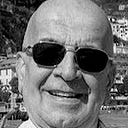In the quest to understand the bee brain …
In work he performed in 1896, the American zoologist Frederick Kenyon showed that the brain of the tiny bee was infinitely more complex than anyone had imagined, with thousands upon thousands of connection points, and also showed, for the first time in any organism, that neurons fell into clearly identifiable classes. He died, forgotten, in a lunatic asylum:
“American writer and biologist Frederick Kenyon (1867–1941) was the first to explore the inner workings of the bee brain. His 1896 study, in which he managed to dye and characterize numerous types of nerve cells of the bee brain, was, in the words of the world’s foremost insect neuroanatomist, Nick Strausfeld, ‘a supernova.’ Not only did Kenyon draw the branching patterns of various neuron types in painstaking detail, but he also highlighted, for the first time in any organism, that these fell into clearly identifiable classes, which tended to be found only in certain areas of the brain.
One such type he found in the mushroom bodies is the Kenyon cells, named in his honor. Their cell bodies — the part of the neuron that contains the chromosomes and the DNA — decoding machinery — are in a peripheral area enclosed by the calyx of each mushroom body (the mushroom’s ‘head’), with a few additional ones on the sides of or underneath the calyces. A finely arbored dendritic tree (the branched structure that is a nerve cell’s signal ‘receiver’) extends into the mushroom body calyx, and a single axon (the neuron’s ‘information-sending output cable’) extends from each cell into the mushroom body pedunculus (the mushroom’s ‘stalk’).
Extrapolating from just a few of these characteristically shaped neurons that he could see, Kenyon suggested (correctly) that there must be tens of thousands of such similarly shaped cells, with parallel outputs into each mushroom body pedunculus. (In fact, there are about 170,000 Kenyon cells in each mushroom body.) He found neurons that connect the antennal lobes (the primary relays processing olfactory sensory input) with the mushroom body input region (the calyces, where the Kenyon cells have the fine dendritic trees) — and even suggested, again correctly, that the mushroom bodies were centers of multisensory integration.
Kenyon’s 1896 brain wiring diagram [is a marvel]. It contains several classes of recognizable neuron types, with some suggestions for how they might be connected. Many neurons have extensions as widely branched as fullgrown trees — only, of course, much smaller. Consider that the drawing only shows around 20 of a honey bee brain’s ~850,000 neurons. We now know that each neuron, through its many fine branches, can make up to 10,000 connection points (synapses) with other neurons. There may be a billion synapses in a honey bee’s brain — and, since the efficiency of synapses can be modified by experience, near-infinite possibility to alter the information flow through the brain by learning and memory. It is a mystery to me how, after the publication of such work as Kenyon’s, anyone could have suggested that the insect brain is simple, or that the study of brain size could in any way be informative about the complexities of information processing inside a brain.
Kenyon apparently suffered some of the anxieties all too familiar to many early-career researchers today. Despite his scientific accomplishments, he had trouble finding permanent employment, and moved between institutions several times, facing continuous financial hardship. Eventually, he appears to have snapped, and in 1899 Kenyon was arrested for ‘erratic and threatening behavior’ toward colleagues, who subsequently accused him of insanity. Later that year, he was permanently confined to a lunatic asylum, apparently without any opportunity ever to rehabilitate himself, and he died there more than four decades later — as Nick Strausfeld writes, ‘unloved, forgotten, and alone.’
It was not to be the last tragedy in the quest to understand the bee brain.”
Delanceyplace.com is a brief daily email with an excerpt or quote we view as interesting or noteworthy, offered with commentary to provide context. There is no theme, except that most excerpts will come from a non-fiction work, primarily historical in focus, and will occasionally be controversial. Finally, we hope that the selections will resonate beyond the subject of the book from which they were excerpted. Sign up to receive Delanceyplace.com every weekday morning.
